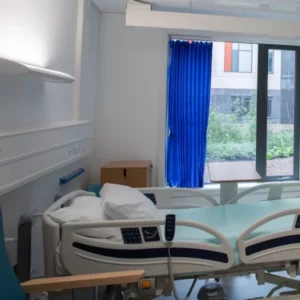Innova Specialise in Complete Ceiling Hoist Solutions
In the field of patient handling, our Ceiling Hoist Systems lead the way, offering safe and efficient transfers in care settings. The AirRise and Airglide360 ceiling lift systems, expertly crafted and installed by our team, set new benchmarks in patient handling. The Airglide360 track system, seamlessly integrated into the ceiling, maintains a non-clinical look, improves infection control, and provides flexibility for full room coverage. Our wall-mounted hoist systems offer a faster installation option, perfect for high ceilings or limited floor space. Combined with the AirRise hoist units, which feature quiet, smooth-rolling twin trolleys and soft-start/stop technology, we transform patient handling into a safer and more comfortable experience.
Ceiling Hoist Tracking
Just as a train relies on tracks for a smooth journey, a hoist unit depends on tracking to glide effortlessly. Our Airglide360 track system is among the most discreet and tidy tracking solutions available. Its unique design allows it to be seamlessly integrated into the ceiling, eliminating the need to hang below. This not only preserves a non-clinical aesthetic but also enhances infection control. The Airglide360 tracking rail system is versatile, suitable for X-Y systems, also known as H-frames, providing full room coverage. Available in two sizes, our Airglide360 tracking is expertly shaped for the smoothest and quietest ride, ensuring optimal control around corners. With a tight radius of just 480mm, our curved sections come in 15, 30, 45, 60, and 90-degree models, tailored to your layout. While our standard rail is white, we are happy to accommodate custom color requests. Contact us if you prefer a different color option.
Ceiling Hoist Tracking Hoist Gate Hoist Gates & Transit Couplings
In any hoist setup involving transitions between layouts and rooms, a gate system is crucial for connecting the corresponding rails. Our innovative Airglide360 Transit Coupling uses a clever combination of magnets and sensors to ensure a secure connection when moving between systems. To engage the Transit Coupling, simply guide the track to the desired position, and it will lock in place seamlessly through the magnetic mechanism. Sensors detect your movement through the coupling, automatically unlocking it as you transfer to the other system. This intelligent system simplifies moving patients and clients between different rooms and tracks, prioritizing their safety and dignity. For more complex overhead track configurations, consider using turntables and track switches to accommodate various routes. Turntables offer automatic rotation within the track layout, allowing for effortless switches between systems. You can choose three or four outlet options to optimize your system’s functionality. Track switches facilitate seamless transitions between different systems or routes. The entire process is automated, ensuring your full attention remains on the person under your care.
Wall Mounted Hoist Systems
If accessing the ceiling is not feasible or your ceiling joists cannot support a hoist system’s weight, our wall-mounted solution may be your best alternative! This system is attached to the wall via sturdy brackets, featuring flat metal plates with protruding sections to securely attach the rails. One of the standout advantages of wall-mounted systems is their remarkably quicker installation process. Unlike ceiling-mounted tracks that require cutting or drilling through the ceiling, wall-mounted systems involve attaching brackets to the wall, onto which the rails are easily slotted. This streamlined installation typically takes only half the time required for a ceiling-mounted system. Furthermore, wall-mounted systems excel in rooms with high ceilings or limited floor space, making them a versatile choice for various environments.
Wall Mounted Hoist Rail ceiling track hoist weight limit AirRise Hoist Units
Any ceiling lift system requires a hoist unit, and our AirRise range is among the best on the market. With built-in quiet, smooth-rolling twin trolleys, our AirRise units handle turns and corners with ease and comfort. The AirRise range also features soft-start and soft-stop technology, ensuring patients and users experience no jerky or unsettling movements. These units are equipped with Battery Protection Software, which helps maintain batteries in prime condition long-term and even alerts you when they need charging! Our AirRise units are available in different models and weight limits. The number at the end indicates the number of kilograms the unit can lift. Choose from the following: AirRise200, AirRise275, AirRise350, AirRise500.

























